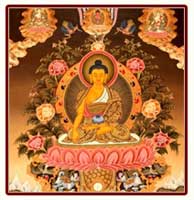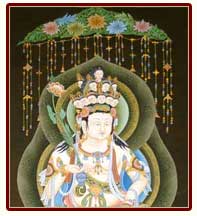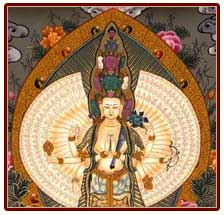Home >
Arts > Paintings > Thangka Paintings
Thangka Paintings are a very much popular Tibetan paintings. A 'Thangka' is also known as 'Tanka' or 'Tangka'. In Tibet the word 'thang' means flat. Thangka Paintings are painted or embroidered with the Buddhist banner. The thangka painting's look is complicated amnd is a composite three-dimensional object. Thangka is a beautiful wall-hanging that is being further decorated with gold, silk and wood.
Thangka paintings are visually very stimulating and usually used for various functions and which even depict the life of the Buddha. The most common shape in which a Thangka Paintings is done is in the upright rectangular form.
The origin of the basic and the original Thangka painting is from the ancient Indian religious art. These paintings even today are heavenly drawn inspirations from Nepalese, Chinese and Kashmiri styles. Thangkas are very much flexible that can also be rolled and called a scroll-painting. A Thangka painting is an object which craves for devotion, spiritual practice, and is a harbinger of blessings. Thangkas exclusively comes in variety of styles, portraying the Buddha and other Hindu deities. It is believed that the hanging painting which brings blessings in the household and serves as a constant reminder of the Buddha's teachings of compassion, kindness and wisdom.

Thangka paintings are especially painted or embroidered Buddhist banners which are hung in a monastery or a family altar or even carried in ceremonial processions. They were also used by traveling monks who carried them from one monastery to another. In Tibetan language, Thang means flat and implies painting done on a flat surface.

Thangka paintings are divided into various categories such as:
• Stained in colors• Applique
• black, red and gold background
• block prints
• embroidery

To make a Thangka requires skill, meticulous detail, mastery in sketching, mastery in techniques and skill to grind. Thangka painting is embellished with paints, gold, and mounting the finished work in brocade. Thangka is a Tibetan silk painting with embroidery, usually depicting a Buddhist deity, famous scenes, a mandala os some sort.
The Thangka is not a flat creation like an oil painting or acrylic painting. Rather it consists of a picture panel which is painted or embroidered, over which a textile is mounted, and then over which is laid a cover, usually silk. Generally Thangkas last a very long time and retain much of their lustre, but because of their delicate nature, they have to be kept in dry places where moisture won't affect the quality of the silk. It is sometimes called a "scroll painting".
Originally, Thangka painting became popular among travelling monks because the scroll paintings were easily rolled and transported from monastery to monastery. These Thangkas served as an important teaching tool depicting the life of Buddha, various influential lamas and other deities and bodhisattvas. One popular subject is the Wheel of Life, which is a visual representation of the Abhidharma teachings (Art of Enlightenment). To Buddhist people these Tibetan religious paintings offer a beautiful manifestation of the divine, being both visually and mentally stimulating.


